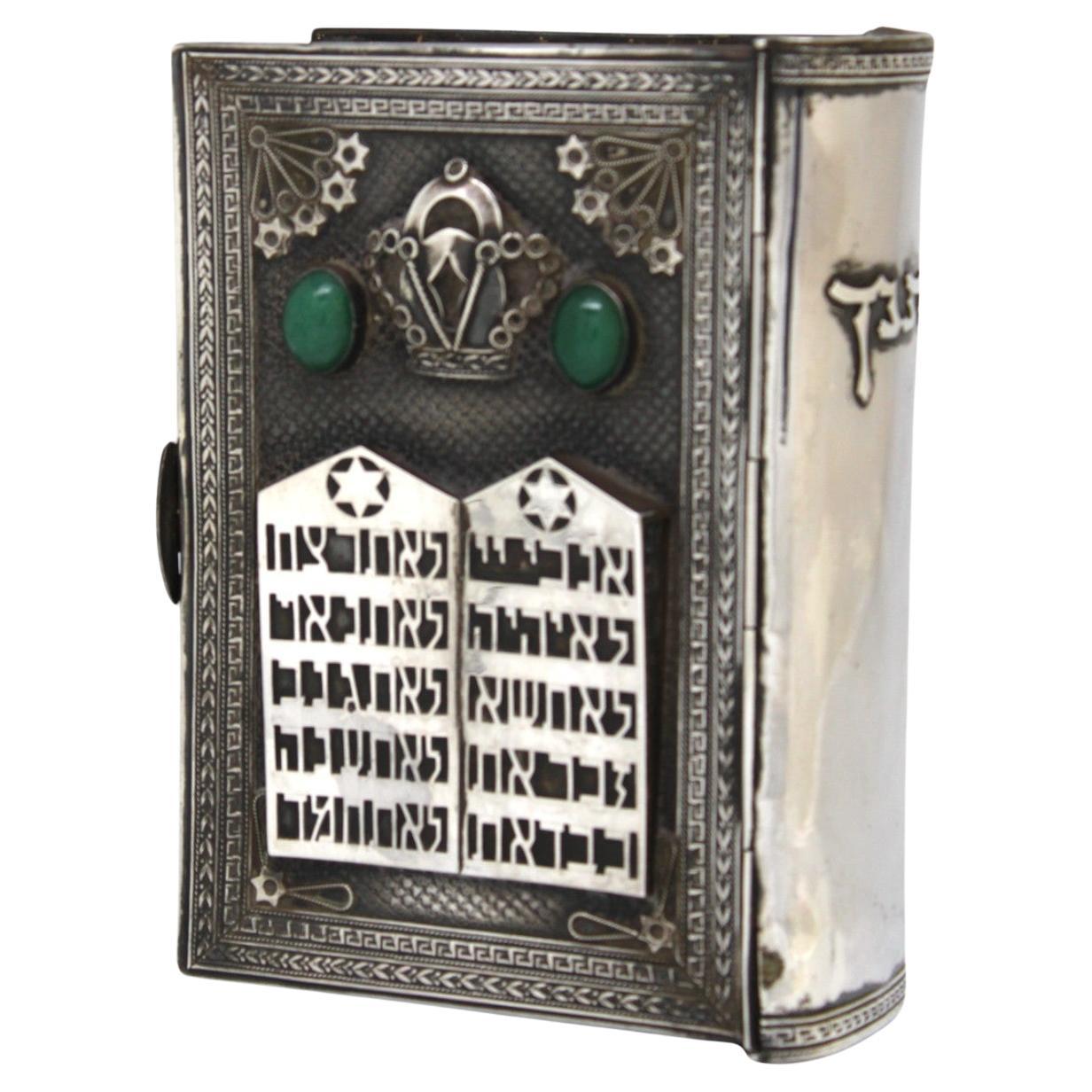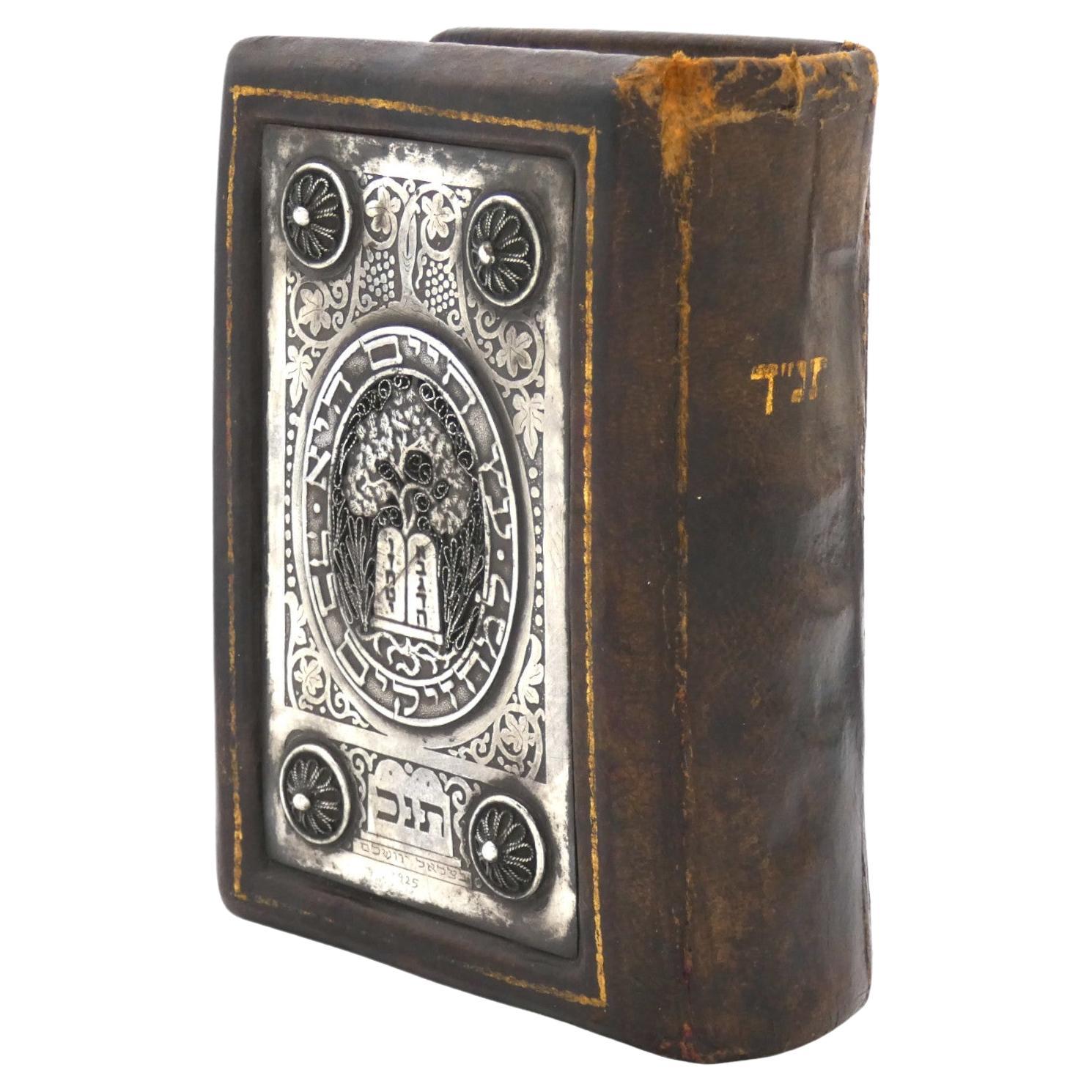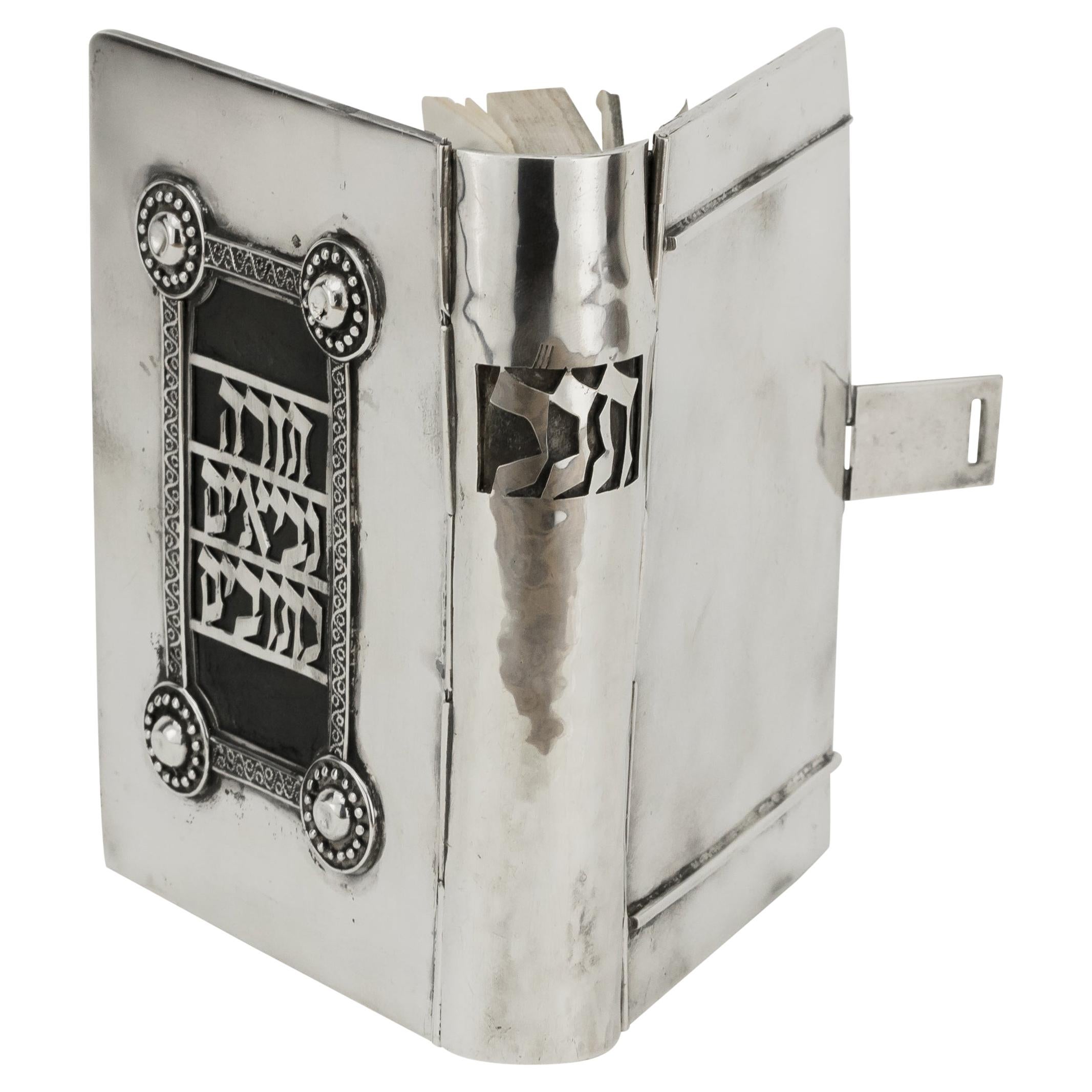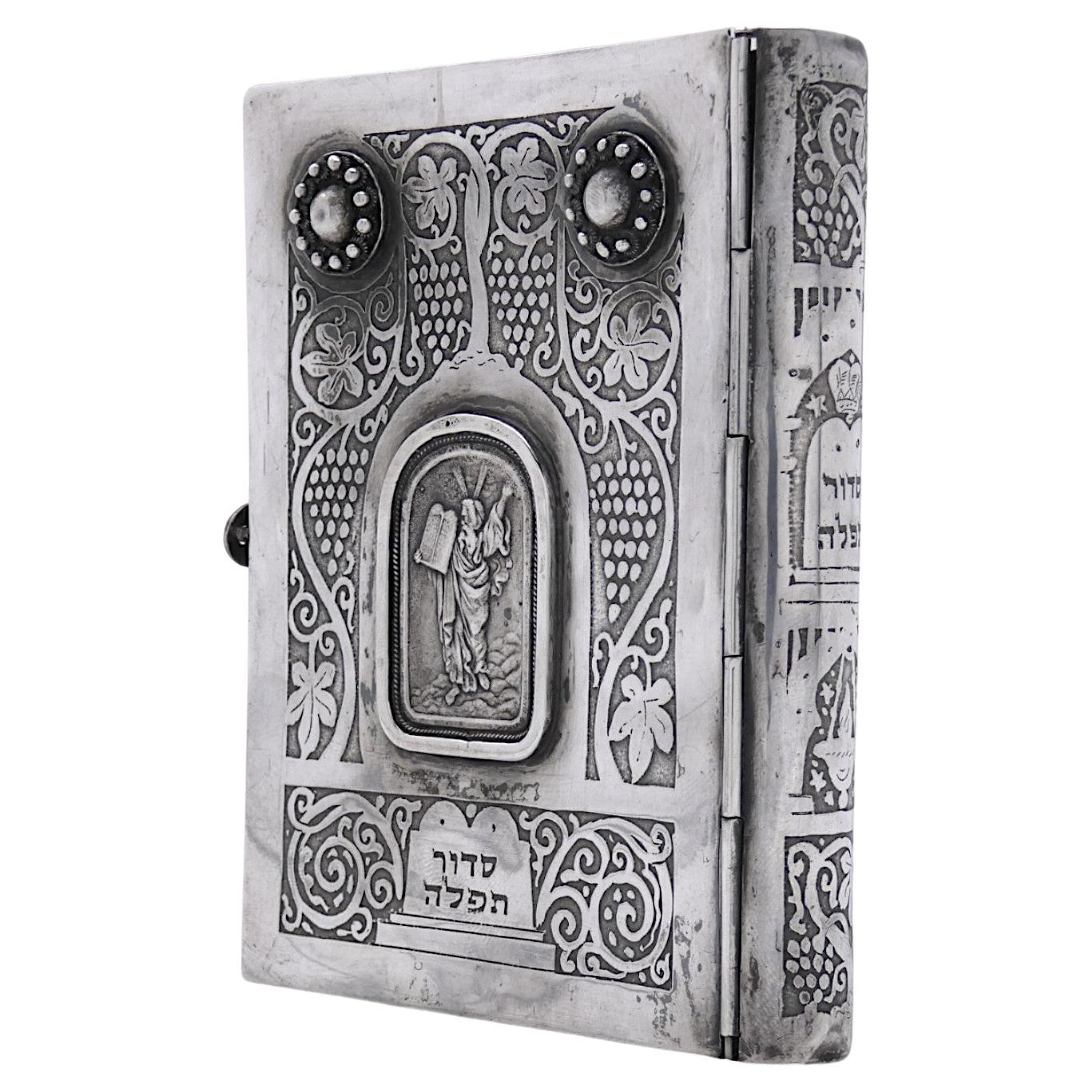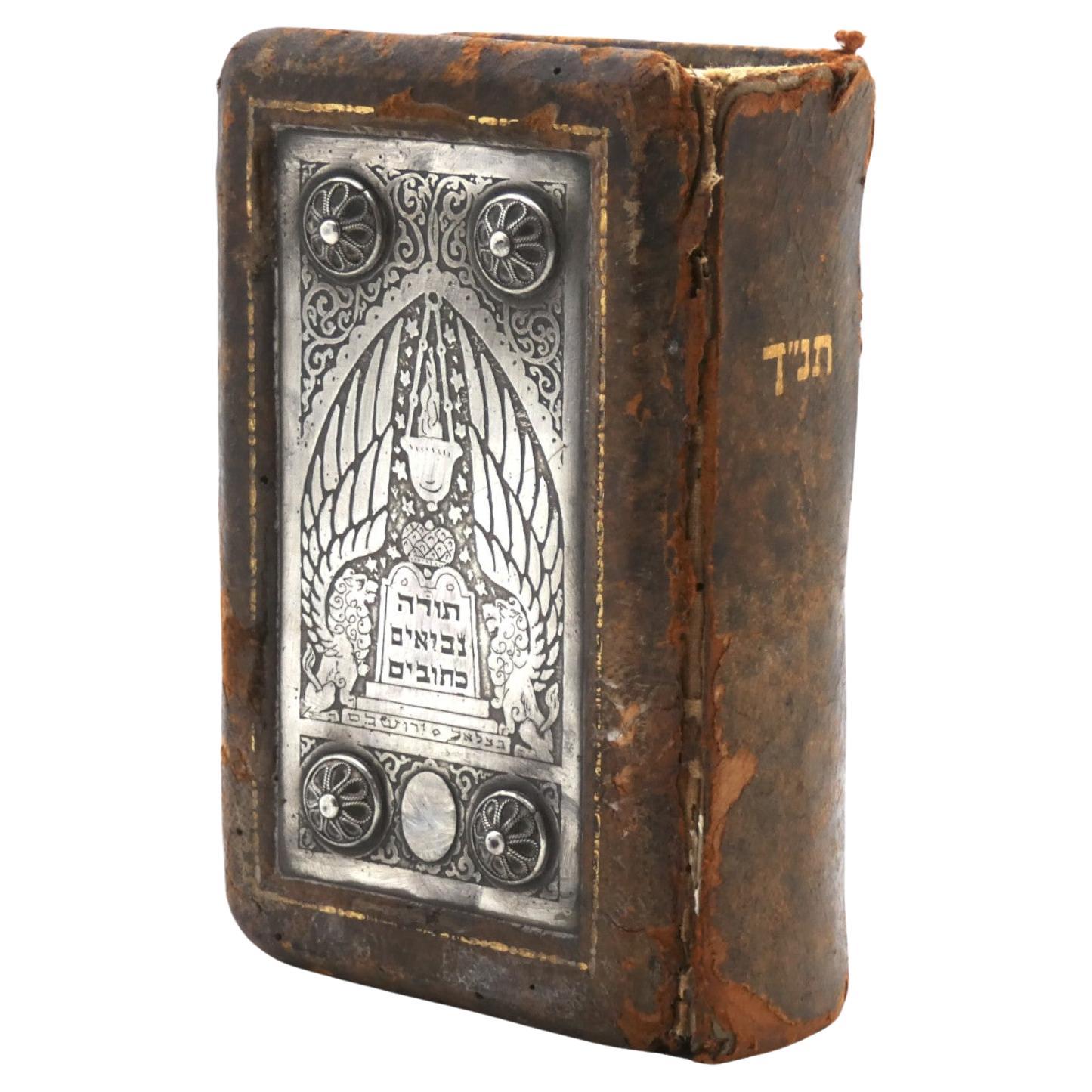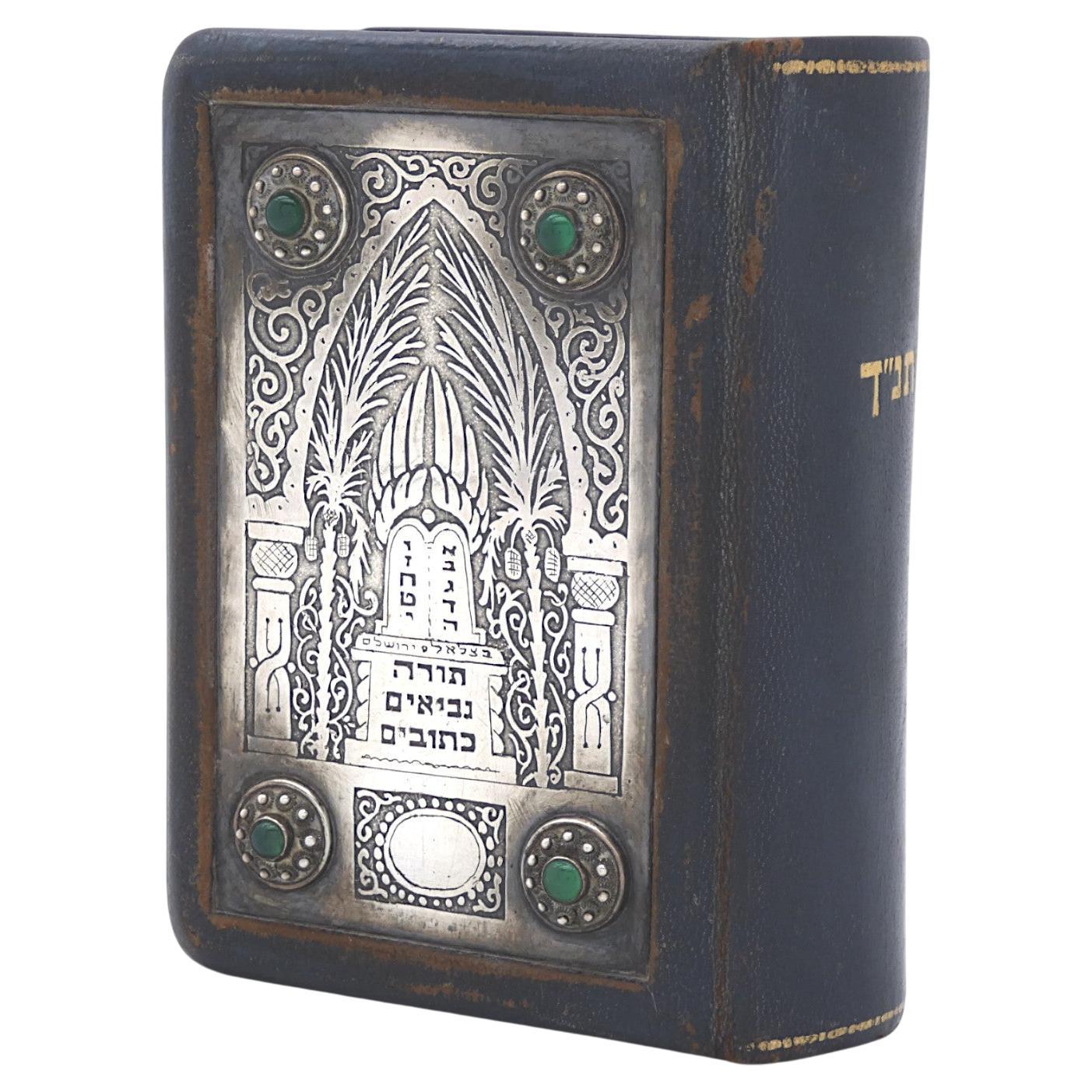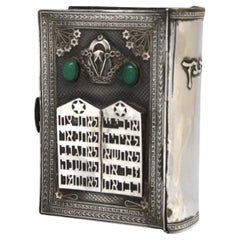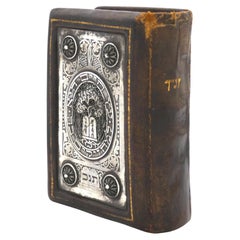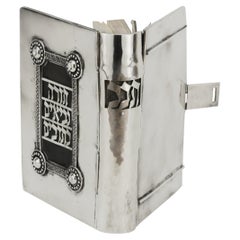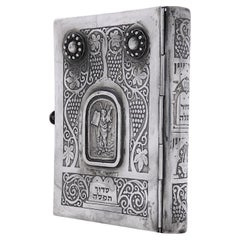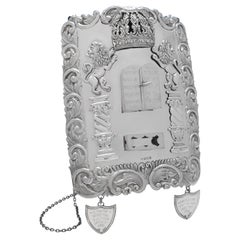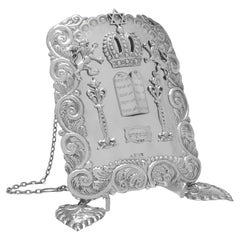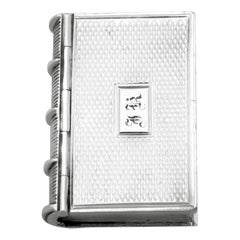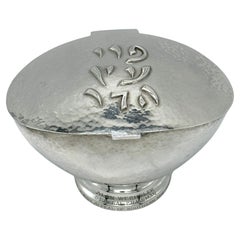Items Similar to A Sterling Silver Siddur Binding Israel C. 1950
Want more images or videos?
Request additional images or videos from the seller
1 of 8
A Sterling Silver Siddur Binding Israel C. 1950
$2,000
£1,527.80
€1,755.29
CA$2,859.57
A$3,150.58
CHF 1,630.93
MX$37,933.80
NOK 20,651.53
SEK 19,400.81
DKK 13,106.59
About the Item
This exquisite sterling silver Siddur binding is a masterful work of Judaica, crafted with exceptional artistry and devotion. The front cover is adorned with a striking depiction of the Luchot HaBrit (Tablets of the Covenant), inscribed with the Ten Commandments and crowned with a regal keter (crown), symbolizing divine authority and reverence. Surrounding this central motif is an intricate filigree framework set against a meticulously checkered background, adding depth and elegance to the design.
Enhancing its grandeur, four encased emerald-colored stones punctuate the composition, their rich hue providing a beautiful contrast to the silver craftsmanship. The spine proudly bears the embossed Hebrew word "סידור" (Siddur), while a finely crafted pierced clasp ensures the prayer book remains securely closed when not in use.
The reverse of the binding is equally captivating, featuring an elaborate arrangement of octagonal roundels, each delicately chased with the symbols of the Shevatim (Twelve Tribes of Israel). A magnificent and meaningful piece, this sterling silver Siddur binding seamlessly blends religious significance with masterful artistry.
- Dimensions:Height: 6.7 in (17 cm)Width: 5.52 in (14 cm)Depth: 2.29 in (5.8 cm)
- Materials and Techniques:
- Place of Origin:
- Period:
- Date of Manufacture:1950's
- Condition:Wear consistent with age and use.
- Seller Location:New York, NY
- Reference Number:1stDibs: LU5281243994952
About the Seller
5.0
Recognized Seller
These prestigious sellers are industry leaders and represent the highest echelon for item quality and design.
Established in 2006
1stDibs seller since 2020
141 sales on 1stDibs
Typical response time: 7 hours
- ShippingRetrieving quote...Shipping from: Pomona, NY
- Return Policy
Authenticity Guarantee
In the unlikely event there’s an issue with an item’s authenticity, contact us within 1 year for a full refund. DetailsMoney-Back Guarantee
If your item is not as described, is damaged in transit, or does not arrive, contact us within 7 days for a full refund. Details24-Hour Cancellation
You have a 24-hour grace period in which to reconsider your purchase, with no questions asked.Vetted Professional Sellers
Our world-class sellers must adhere to strict standards for service and quality, maintaining the integrity of our listings.Price-Match Guarantee
If you find that a seller listed the same item for a lower price elsewhere, we’ll match it.Trusted Global Delivery
Our best-in-class carrier network provides specialized shipping options worldwide, including custom delivery.More From This Seller
View AllA Sterling Silver Hebrew Bible Binding by Dugma Israel C. 1950
Located in New York, NY
This exceptional vintage sterling silver Tanach binding, crafted by the renowned Dugma of Israel, is a striking example of fine Judaica craftsmanship. The richly adorned cover showca...
Category
Vintage 1950s Israeli Sterling Silver
Materials
Sterling Silver
A Silver and Leather Bezalel Book Binding, Israel Circa 1940
Located in New York, NY
A Silver and Leather Bezalel Book Binding from Israel circa 1940 is a prominent piece of Judaica. Bezalel, the name associated with the Bezalel School of Arts and Crafts in Jerusalem, is known for its significant contributions to Jewish art and craftsmanship in the early 20th century.
The Bezalel School was founded in 1906 by Boris Schatz in Jerusalem. It aimed to blend European artistic traditions with Middle Eastern and Jewish themes...
Category
Vintage 1940s Israeli Sterling Silver
Materials
Silver
$2,000 Sale Price
20% Off
Mid-20th Century Israeli Silver Book Binding by Yaakov Ettlinger
Located in New York, NY
Tanach (Five Books Of Moses) with silver binding, handmade with dedication handwritten and signed by the President of Israel, Shimon Peres.
With the fiv...
Category
Vintage 1950s Israeli Mid-Century Modern Religious Items
Materials
Silver
$5,060 Sale Price
46% Off
A Silver Bezalel Bookbinding, Israel mid-20th Century
Located in New York, NY
A Distinguished Silver Bezalel Bookbinding made in Israel in the mid-20th Century.
The silver Bezalel book binding is a classic example of the handiwork that was made in the mid-20...
Category
Mid-20th Century Israeli Sterling Silver
Materials
Silver
$2,400 Sale Price
46% Off
A Silver and Leather Bezalel Book Binding, Jerusalem Circa 1930
Located in New York, NY
A Silver and Leather Bezalel Book Binding from Israel circa 1940 is an important piece of Judaica. Bezalel, the name associated with the Bezalel School of Arts and Crafts in Jerusalem, is known for its significant contributions to Jewish art and craftsmanship in the early 20th century.
The Bezalel School was founded in 1906 by Boris Schatz in Jerusalem. It aimed to blend European artistic traditions with Middle Eastern and Jewish themes. By the 1930s, the Bezalel School had established a reputation for high-quality, handcrafted Judaica that incorporated traditional Jewish motifs and modern design elements.
A Bible printed by a publishing company in London, Great Britain in 1932 is bound within an original brown leather binding. Vine, grape cluster motifs, two winged lions flanking a crowned Decalogue, and a flaming Ner...
Category
Vintage 1930s Israeli Sterling Silver
Materials
Silver
$2,000 Sale Price
20% Off
A Leather and Silver Bookbinding by Bezalel , Jerusalem Circa 1913
Located in New York, NY
A Rare Leather and Silver Bookbinding by Bezalel made for a Bible, in Jerusalem Israel Circa 1913.
Besides the unique craftmanship that went into making this attractive leather bind...
Category
Vintage 1910s Israeli Sterling Silver
Materials
Silver
$3,600 Sale Price
20% Off
You May Also Like
Traditional Antique Sterling Silver Breastplate, Judaica, London 1922
Located in London, London
Hallmarked in London in 1922 by Morris Solovitch, this striking, Sterling Silver Breastplate, features decoration depiction the tablets with the engraved Ten Commandments in Hebrew, ...
Category
Vintage 1920s English Sterling Silver
Materials
Sterling Silver
Antique Sterling Silver Breastplate - Judaica - London 1922 Jacob Rosenzweig
Located in London, London
Hallmarked in London in 1922 by Jacob Rosenzweig, this Antique Sterling Silver Breastplate, is of traditional form, decorated with two Lions of Judah holding a depiction of the Crown...
Category
Vintage 1920s English Religious Items
Materials
Sterling Silver
Antique William IV Sterling Silver Book Vinaigrette
By Gervase Wheeler
Located in Jesmond, Newcastle Upon Tyne
An exceptional, fine and impressive antique William IV English sterling silver vinaigrette in the form of a book; an addition to our silver boxes collection.
This exceptional antique William IV sterling silver vinaigrette has been realistically modelled in the form of a book.
The surface of this antique vinaigrette...
Category
Antique 1830s English Sterling Silver
Materials
Sterling Silver
JUDAICA SILVER ETROG BOX DESIGNED BY LUDWIG WOLPERT. New York, 20th century
Located in Tel Aviv - Jaffa, IL
This charming piece of jewish history in front of you is a one of kind modern Judaica object,
This box used to hold the Etrog To protect the it during the holiday of Sukkot, it is traditionally Wrapped in silky flax fibers and stored in a special decorative box, mostly made from silver.
Wolpert designed this amazing hand hammered Bauhaus style box in 1963-1964 while he was Working in New York. all of the boxes we could found from this design made by Wolpert have The upper part inscribed in a simple engraving with the phrase "Pri Etz Hadar"
In Hebrew ״פרי עץ הדר״. the box in front of you is the only example in existence as far as we Know where the letters are also repoussé and also engraved, such a beautiful and hard to get Combination, the rest of the box is shaped as a modernistic Etrog, all the body of the box is Skillfully hand hammered in a way it reflects the light in a warm and calm way, a true Masterpiece of modern judaica by the great and important artist Ludwig Yehuda Wolpert.
One of the the two great masters of 20th century Judaica.
the Box is marked "WOLPERT" AND "STERLING" and the base has the engraved inscription :
"ALAN WECHSLER GENERAL CHAIRMAN, ALLIED JEWISH APPEAL OF SOUTHERN NEW JERSEY 1978"
Similar boxes can be find in museum collections around the world
In the Jewish Museum New York
In the North Carolina Museum of Art
In The Derfner Judaica Museum
Another similar box was featured in the Israel Museum exhibition
"Forging Ahead, Wolpert and Gumbel, Israeli Silversmiths for the Modern Age"
Ludwig Yehuda Wolpert was born in Hildesheim, Germany, to an Orthodox family. In 1916-1920, He began his studies in sculpture at the Frankfurt School of Art. In 1925-1928, he studied Goldsmithing at the Frankfurt School of Art.
Following the presentation of the works in the 1930 exhibition "Kult und Form" ("Ritual and Form") at the Jewish Museum in Berlin, his works became well known in the German Jewish World. His works were greatly influenced by Modernist design, especially the Bauhaus Movement. Wolpert's works avoid decoration, relying on clean, geometric shapes. In 1933, Following the Nazi rise to power in Germany, he immigrated to the Mandatory Palestine with His family. There he worked for two years in the workshop of Bernhard Friedländer, where he Designed and produced silverware and Jewish ceremonial art.Together with Victor Solomon...
Category
Vintage 1960s Decorative Boxes
Materials
Silver
extremely rare Algerian Judaica silver, jewish Dowry box early 19th century
Located in Tel Aviv - Jaffa, IL
Amazing and scarce JUDAICA object, we have here one of the most touching jewish objects we had for a long time, this small silver dowry box was made in Algeria in the early 19th century, it is all covered with symbols of jewish faith and of couples, the sliding lid has 2 flanking birds with hamsa (protective hand) on each side and a flower vase in the middle.
one side shows two flanking lions with a tree in the middle and the other side shows again two big and two small birds with a flower bowl in the middle, front side has a key hole and next to it there is the Hebrew inscription ס״ט״" which says Siman tov or in English "a good sign" it is taken from the wedding blessing, underneath the lock there is another inscription with the name ״עזיזה בת אברהם בן חמו״ which is the name of the bride, her father and her grandfathers name.
the box is full marked a lot of times with the silversmith mark, every side of the box is marked.
this box was probably ordered by the grooms family to hold the jewelry they are giving to the bride as dowry, this type of objects are rare and there are just a few of them on museum collections.
DOWRY (Heb. נְדֻנְיָה), the property a wife brings to her husband at marriage; the Yiddish equivalent, nadn, is from the same root. The custom of nedunyah became clearly defined and institutionalized only in the talmudic period. In biblical times, mohar (מֹהַר), whereby the groom bought his wife from her father (Gen. 24:53; Ex. 22:15–16; Hos. 3:2), was the accepted practice. It was then customary that the groom give the bride gifts, and that she bring certain property to her husband's home upon marriage: slaves, cattle, real estate, etc. (cf. Gen. 24:59–61; 29; Judg. 1:14ff.; I Kings 9:16). Evidence of the custom of nedunyah is to be found in Tobit (7:14; 8:21) and in the Assuan papyri (Cowley, Aramaic, nos. 15, 18). Gradually, mohar was superseded by the ketubbah custom according to which the husband merely assumed the responsibility of compensation to his wife in case he divorced her: he had to pay her 200 zuzim if she had been a virgin at the time of marriage, and 100 zuzim if a widow or divorcée (see *Ketubbah).
By talmudic times, the institution of nedunyah was prevalent; the father gave a dowry to the bride since the daughter was excluded from paternal inheritance. Fifty zuzim (equivalent to the worth of 180 grams of silver) was the minimum amount a father was obliged to give to his daughter (Ket. 6:5). Parents usually gave much more, according to their social standing. Community funds provided the dowry for an orphan or a very poor girl (ibid.; cf. Sh. Ar., YD 251:8). In case of her father's death, the brothers of a minor girl were obliged to give her the minimum dowry, and the court estimated how much her father would have given her above the minimum dowry. The sum was then taken out of the father's estate and given to the daughter upon majority (Ket. 6:6; 68a–69b). In the absence of such an estimate, each daughter was entitled to receive one-tenth of the value of her father's estate in money, or in valuables (Yad, Ishut, 20:4–7; Sh. Ar., EH 113:4). If the father was unable or unwilling to pay the promised dowry at the betrothal ceremony, the groom could refuse to marry his bride (Ket. 13:5; Ket. 108b–109a). Insistence on exact payment of the promised dowry, however, was frowned upon by later rabbinic authorities (Rema to Sh. Ar., EH 2:1). In certain communities it was customary for the groom's father to make a dowry contribution equal to that of the bride's father (Ket. 102b). The dowry, whether given in real estate, slaves, money, or chattel was recorded in the marriage contract (the ketubbah) and in some instances one-third or one-fifth of the actual value of the dowry was added to the sum mentioned in the ketubbah. Based upon a decree enacted by *Simeon b. Shetah (first century C.E.), the Talmud ruled that the husband and his entire property were liable for compensation as stipulated in the ketubbah, either in case he died (when she collected the sum specified in the ketubbah from the heirs) or in case he divorced his wife (Ket. 82b). For the status of the dowry and the husband's rights and obligations, see below. The rabbinic enactments (Takkanot Shum) by R. Jacob *Tam and by the rabbinic synod of the communities of Speyer, Worms, and Mainz (Germany) stipulated that if a woman died...
Category
Antique Mid-19th Century Algerian Tribal Art
Materials
Silver
Sterling Silver Antique Judaica Torah Breast Plate, Late 19th Century
Located in London, GB
Sterling silver antique Judaica Torah breast plate, Late 19th century
Continental, 1882
Height 34cm, width 26cm, depth 5cm
This wonderful piece of...
Category
Antique Late 19th Century European Religious Items
Materials
Silver, Sterling Silver
More Ways To Browse
Silver Binding
Sterling Brush Comb And Mirror
Sterling Pepper Grinder
Sterling Silver Cocktail Fork
Sterling Silver Knife Rests
Sterling Silver Pierced Bowl
Sterling Silver Vesta Match
Tiffany Silver Salt And Pepper
Tiffany Sterling Compote
Tiffany Sterling Ice Cream Servers
Tiffany Sterling Repousse
Tiffany Sterling Silver Waves Edge
Unger Bros
Vanity Brush Set
Vintage Tiffany Cups
William And Mary Sterling Silver Flatware
Yemen Silver
950 Japan
